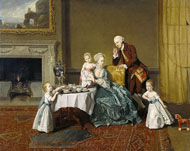Grades/Level: Lower Elementary (K–2), Upper Elementary (3–5), Middle School (6–8), High School (9–12), Adult Learners |
|
||||||||||||||||||||||||||||||||||||||||||||||||||||||||||
Lesson Overview |
|||||||||||||||||||||||||||||||||||||||||||||||||||||||||||
This lesson focuses on a family depicted in a work of art. Students practice using vocabulary related to people and families. Activities emphasize oral and written descriptions of the people portrayed in the work of art, using possessive adjectives. Students are challenged to infer what the relationships are between figures depicted and what individuals are doing, based on such clues as their pose. |
|||||||||||||||||||||||||||||||||||||||||||||||||||||||||||
Learning Objectives |
|||||||||||||||||||||||||||||||||||||||||||||||||||||||||||
Students will be able to: |
|||||||||||||||||||||||||||||||||||||||||||||||||||||||||||
Materials |
|||||||||||||||||||||||||||||||||||||||||||||||||||||||||||
• Reproduction of John, Fourteenth Lord Willoughby de Broke, and His Family
by Johann Zoffany
• Information for Teaching about John, Fourteenth Lord Willoughby de Broke, and His Family by Johann Zoffany |
|||||||||||||||||||||||||||||||||||||||||||||||||||||||||||
|
|||||||||||||||||||||||||||||||||||||||||||||||||||||||||||
Lesson Steps |
|||||||||||||||||||||||||||||||||||||||||||||||||||||||||||
1. Introduce the vocabulary words painting and portrait from the Art Vocabulary. Explain that portraits are pictures of real people. Display a reproduction of John, Fourteenth Lord Willoughby de Broke, and His Family. Explain that it is a portrait of several people (a group portrait). (Refer to the Information for Teaching about John, Fourteenth Lord Willoughby de Broke, and His Family by Johann Zoffany.)
4. Ask yes/no questions about the figures' relationships to one another. Challenge students to reply using possessive adjectives, and write examples on the board:
5. Have students look closely at the image on the handout and write three descriptive sentences in the simple present tense using possessive adjectives. Examples: John Peyto looks at his son George. Lady Louisa holds her daughter. John Jr. plays with his toy horse. 6. Distribute paper and pencils. Ask students to make a sketch of their family members or friends doing something together at home. Tell students they can use stick figures to illustrate what the individuals are doing. Encourage students to think about adding details to their drawings that would give clues about the people's actions. 7. Have students identify the figures in their portrait and describe what these individuals do regularly. Instruct students to use simple present tense when responding. Examples: This is my son Miguel. He plays baseball. This is my brother Fernando and his wife. They eat hot dogs on Sundays. 8. Ask students to share what's similar and different between their own family portrait and Zoffany's painting. Examples: Both portraits show children. My portrait has one child. Zoffany's portrait has three children. Both portraits show the family doing something together. |
|
||||||||||||||||||||||||||||||||||||||||||||||||||||||||||
Extensions |
|||||||||||||||||||||||||||||||||||||||||||||||||||||||||||
|
|||||||||||||||||||||||||||||||||||||||||||||||||||||||||||




